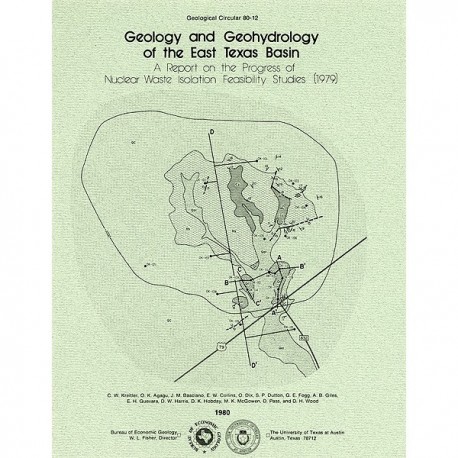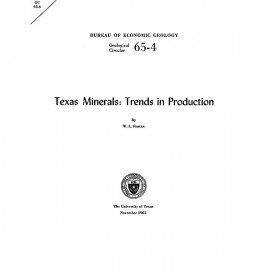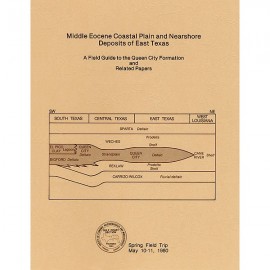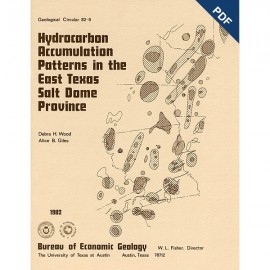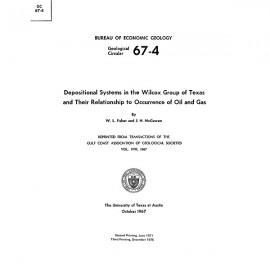Geological Circulars
-
Books & Reports
- Reports of Investigations
- Guidebooks
- Udden Series
- Geological Circulars
- Down To Earth
- Atlases of Major Oil and Gas Reservoirs
- Texas Memorial Museum Publications
- Environmental Geologic Atlas of the Texas Coastal Zone
- Mineral Resource Circulars
- Other Reports
- Seminars and Workshops
- Handbooks
- Submerged Lands of Texas
- Symposia
- Annual Reports
- Open File Reports
-
Maps & Cross Sections
- Thematic Maps
- Miscellaneous Maps, Charts & Sections
- Geologic Atlas of Texas
- STATEMAP Project Maps
- Geologic Quadrangle Maps
- Cross Sections
- Highway Geology Map
- Energy and Mineral Resource Maps
- Shoreline Change and Other Posters
- Wilcox Group, East Texas, Geological / Hydrological Folios
- Bouguer Gravity Atlas of Texas
- River Basin Regional Studies
- Featured Maps
- Posters
- Teachers & the Public
-
Geological Society Publications
- Gulf Coast Association of Geological Societies
- Alabama Geological Society
- Austin Geological Society
- Corpus Christi Geological Society
- Houston Geological Society
- Lafayette Geological Society
- Mississippi Geological Society
- New Orleans Geological Society
- South Texas Geological Society
- GCS SEPM Publications
- Historic BEG & UT Series
Geology and Geohydrology of the East Texas Basin, A Report on the Progress of Nuclear Waste Isolation Feasibility Studie
GC8012
A free, digital version of this publication can be found on: Texas ScholarWorks
GC8012. Geology and Geohydrology of the East Texas Basin, A Report on the Progress of Nuclear Waste Isolation Feasibility Studies (1979), by C. W. Kreitler, O. K. Agagu, J. M. Basciano, E. W. Collins, O. Dix, S. P. Dutton, G. E. Fogg, A. B. Giles, E. H. Guevara, D. W. Harris, D. K. Hobday, M. K. McGowen, D. Pass, and D. H. Wood. 112 p., 66 figs., 5 tables, 1980. ISSN: 0082-3309: Print.
To purchase this publication as a PDF download, please order GC8012D.
ABSTRACT
Analysis during the second year was highlighted by a historical characterization of East Texas Basin infilling, the development of a model to explain the growth history of the domes, the continued studies of the Quaternary in East Texas, and a better understanding of the near-dome and regional hydrology of the basin. Each advancement represents a part of the larger integrated program addressing the critical problems of geologic and hydrologic stabilities of salt domes in the East Texas Basin.
During the second year of the East Texas salt dome studies, significant advances in understanding the hydrologic and geologic stabilities of salt domes were based on the acquisition of much new data. Among these new sources of data are (1) 400 km (250 mi) of seismic reflection data that are both regional and site specific, (2) gravity data for the East Texas Basin, (3) 20 shallow boreholes over Oakwood Dome, (4) 1 hydrologic test hole downdip from Oakwood Dome, and (5) a complete core of the anhydrite-gypsum cap rock over Gyp Hill Dome in South Texas.
The acquisition of seismic, gravity, and electric log data provided new understanding of the sedimentary infilling of the East Texas Basin and how it caused salt migration and dome growth. Deposition of the Travis Peak-Schuler sediments caused the first differential loading of the underlying Louann Salt and the migration of the salt into anticlinal ridges. Subsequent clastic depocenters occurred laterally to Travis Peak depocenters and caused further migration of the salt into diapirs. The greater the sediment loading, the further the salt anticline advanced through Trusheim's (1960) growth sequence: pillow structure to immature diapir and finally to a mature diapir. Most domes in the basin can be placed within this dome growth sequence.
Analysis of the Gyp Hill cap rock showed that the cap rock was the result of salt dome dissolution and the accumulation of the insoluble residuum, anhydrite.
Work completed on the Carrizo-Wilcox aquifer, the major fresh-water aquifer in the basin, shows that this aquifer has the greatest potential for causing dome dissolution leading to radionuclide transport. Ground-water circulation is controlled primarily by topography and structure. Fluid movement is generally downward because of the structural dip and leakage from overlying units. Chemical composition of the water evolves from a low-pH, oxidizing, calcium bicarbonate water in the outcrop to a high-pH, reducing, sodium bicarbonate water deeper in the aquifer. This chemical change has important implications for radionuclide transport.
Keywords: waste isolation, East Texas Basin, geologic modeling, Oakwood Dome, Gyp Hill Dome, Carrizo-Wilcox aquifer, geohydrology, Texas
Citation
Kreitler, C. W., Agagu, O. K., Basciano, J. M., Collins, E. W., and others, 1980, Geology and Geohydrology of the East Texas Basin, A Report on the Progress of Nuclear Waste Isolation Feasibility Studies (1979): The University of Texas at Austin, Bureau of Economic Geology, Geologic Circular 80-12, 112 p. doi.org/10.23867/gc8012.
